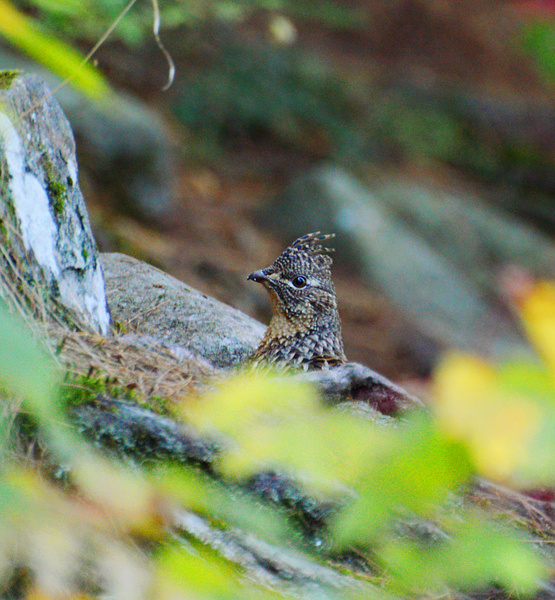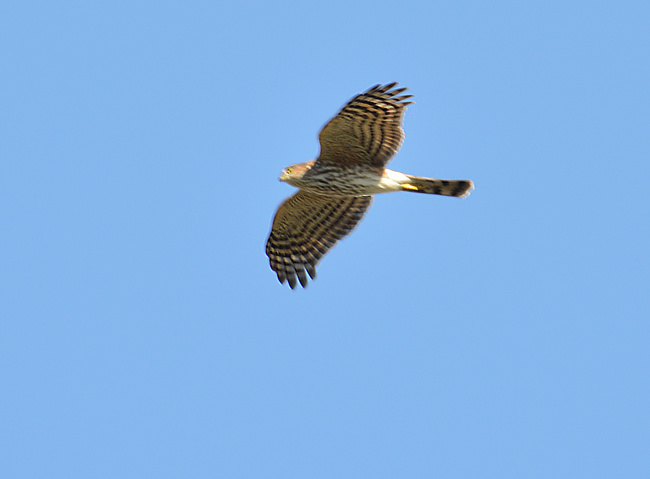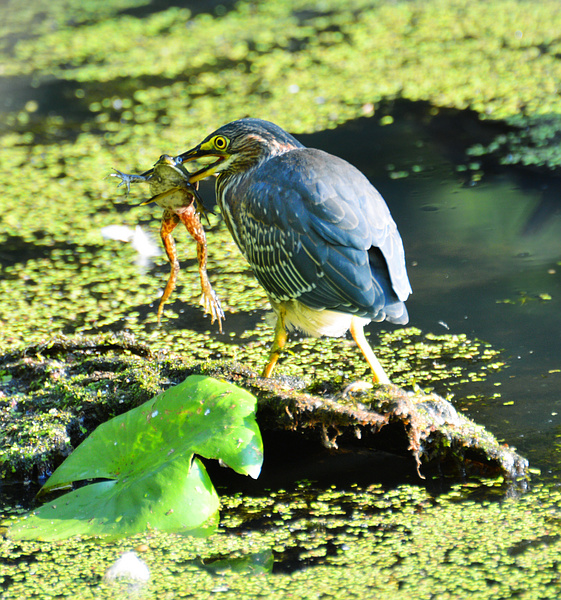
Late Afternoon at Andrew Haydon Park
November 15th, 2016



A distant pair of Long-Tailed Ducks on the Ottawa. I seldom find these handsome sea ducks (present here only in migration), and never had the chance to photograph them in the wild before.


Downy Woodpecker
An Exciting Ottawa Lister
November 10th, 2016
I was thrilled this week to stumble upon a pair of Trumpeter Swans--a new species for my Ottawa list, and only my third sighting of it ever.



Trumpeter Swans are the largest waterfowl in North America. They are one of our two species of native swans. (Nota bene, the swans frequently seen on the Rideau River in summer are not native and not countable for birders, though they are beautiful!) Trumpeters were driven to the brink of extinction once, primarily by market hunting, but recovery efforts have restored their population to the tens of thousands, with over a thousand in Ontario alone. Numbers continue to rebound, and in the past few years there has been a breeding pair reported on the Jock River. We can well hope to see more of them here in Ottawa in the years to come!
They are nonetheless still a vulnerable species. They need pristine wetlands and a minimum of human disturbance during nesting time. Hunting them is, thankfully, not legal in Ontario, but it only takes a few unethical hunters to do harm. Here's hoping that this pair remains as healthy and unharassed as I found them.
Algonquin Park in Autumn (part 3)
October 29th, 2016
This final part is dedicated to the best (IMO) of my husband's scenery photos. The first two are from Barron Canyon.


High Falls is sort of an open secret in the north Algonquin backcountry. An inconspicously marked trail (it's called "cheater's trail", because, I suppose, the proper way to get to High Falls is by canoeing!) leads you, after five kilometers or so, to a gorgeous panoramic view of a set of interconnected pools and shallow waterfalls. One of the falls is used as a natural water slide in summer. They say, no joke, that the rock is so well-greased with blackfly eggs, it makes for a smooth and comfortable ride. (NOT recommended during spring runoff, however.)
It would have taken an ultra-wide-angle lens to capture the whole view. But what Mike could capture came out beautifully.

1920x1080 wallpaper

1920x1080 wallpaper
Algonquin Park in Autumn (part 2)
October 23rd, 2016
There were two birdy high points on an otherwise not-very-birdy vacation. Number two was this fellow:

This Ruffed Grouse was right on the trail, and surprisingly reluctant to flush or even sneak away. Not a rare bird by any means, but seldom giving so lengthy and satisfying a view! (Frequently the only indication that you've stumbled upon a grouse is the sound of it flying away.) Its head bobbed up and down as it pecked at something unseen. When we walked by where it had been, we saw a large half-eaten mushroom.
The number one high point was, alas, unphotographed. That was when I spotted a young Bald Eagle perched on the rocks across a small pond. It was the single best, closest view of a juvenile eagle that I've ever had, and Mike got a great view of it too. It soon flew off, whereupon a collection of ravens and vultures flew in, congregating in and around a clump of tall vegetation to the left of the rocks. We realized there must be carrion in there--sizable carrion, given that all of these birds were feeding peacably on it! It may originally have been prey to the eagle, but it's at least as likely that the eagle, too, was a scavenger. (Unlike their cousins Golden Eagles, Bald Eagles don't often prey on live mammals. They prefer fish and carrion.) At one point something spooked them, and four ravens and one vulture all emerged, all previously unseen save for one raven's tail, from that one little clump.
It was also neat to see two of the vultures doing their best cormorant imitation (perching on the rocks and spreading their wings to dry.)
Migrating kinglets were everywhere, and migrating White-Crowned Sparrows were likewise everywhere. One of the latter paused just long enough in an opening for me to photograph it. Like most of the ones we saw, it was a juvenile. (See this post from back in May to compare and contrast with a mature adult.)


This odd little plant is called Indian Cucumber Root. Its design put me in mind of Painted Trillium, but it's actually part of the lily family. There were lots of them along the Hardwood Lookout Trail, some holding single blue berries on top. The berries are not edible, but the roots are and they really do taste like cucumber.

Beaver at sunset along Mizzy Lake Trail.
Algonquin Park in Autumn (part 1)
October 17th, 2016
Michael and I spent four days in Algonquin Park early in October, and had a wonderful time all in all. Bird-watching was poor: no boreal specialties, only common landbird migrants, and a surprising dearth of migrating waterbirds. (I think the weather was just so nice that the attitude for many was, as Mike put it, "what do you mean, migrate? I'm starting a second clutch!") But the Algonquin fall colors were at their absolute peak, and that made up for it. It wasn't in my bucket list to see Algonquin at peak autumn, but it should have been.
It was uncapturable. I don't think anyone could fully capture such beauty on camera; you have to see it for yourself. (Mom: you really need to visit in October sometime, this place is only two and a half hours away from us!) But that didn't stop me from trying.

I took scenery photos as best I could with my somewhat ill-suited telephoto lens. My favorites were the ones I got along Mizzy Lake Trail, with classic boreal spruce bog in the foreground, and blazing fall maples in the backdrop. The best of both words.

1680x1050 wallpaper
Surprises on the Trans-Canada Trail
October 13th, 2016
A tip on Facebook led me to a section of the Trans-Canada Trail I had never hiked before. I heard that Fringed Gentian, a wildflower with which I have rather fallen in love, could be found in abundance there, if you knew where to look. I didn't ask for details (I didn't know if he'd want to give up his secret, and besides, it's more fun to make it a treasure hunt); instead Michael and I just went to the trail and explored.
It was pretty well off-trail where we found the motherload: dozens of them, some growing in dense stands. Fringed Gentian is enormously picky about sunlight, and in the late-afternoon partly-cloudy conditions we found them in, they were all mostly closed. I promised myself to come back soon on a sunny mid-morning.
So I did, and after much poring over the site in search of the perfect photo op, I found these three lovely ladies. They were standing up against a hillside with the sun behind it, open and waiting. I waited with them until it arrived.

1680x1050 wallpaper
The abundance of limestone quarries in the area provided a clue as to why Fringed Gentian was so happy there. Limestone bedrock is one of their favorites. Other interesting wildflowers were in evidence also, including Harebells and some wild geraniums that Mike tentatively identified as Bicknell's Cranesbill. The land and flora reminded me of both Carp Ridge and the Burnt Lands.
The birding was far better than I expected. Both a juvenile Sharp-Shinned Hawk and a juvenile Red-Shouldered Hawk flew over while I was photographing gentians. Red-Shouldered Hawk is very uncommon in Ottawa, only my second ever here. Back on the trail, I was stunned to find an Eastern Towhee, another highly uncommon bird, seldom seen in Ottawa except for its small breeding population in the Carp Ridge barrens. (Sadly, my photos of these two excellent birds are not worth showing. Exposure fail.)
Across the trail from the towhee, what sounded like a sizable flock of Rusty Blackbirds was twittering in some dense spruces. I couldn't see a one of them, except for a lone sentry who perched at the very top of a spruce to look around. Rusties are uncommon, declining blackbirds who nest and forage in wetlands. Most of them breed in the boreal forest.


Palm Warbler, one of our earliest (in spring) and latest (in fall) migrant warblers. They favor spruce bogs for nesting. A small number of pairs breed at Mer Bleue bog each year.

Eastern-Tailed Blue

Sharp-Shinned Hawk
If you would like to explore this area yourself, it's in Stittsville around where Jinkinson Road crosses the TCT. There's a parking lot for trail users there.
My First Proper Lincoln's
October 2nd, 2016
On September 19th, an honorary lifer at the Goulbourn Sparrow Field! This spot--actually just a weedy hydro cut near the Trans-Canada Trail--was discovered recently by Jon Ruddy as being a motherload of migrant sparrows. It's the kind of spot (small, choked with non-native weeds, bordered by recent housing developments) that you might look at and instantly dismiss as having any potential for nature-watching, but birds are sometimes less picky than we expect, at least in migration. Weedy patches, suburban back yards, and puddles in snow dumps can be as worth exploring as pristine forests and wetlands.
Lincoln's Sparrow has always been one of my nemesis birds. It's a bashful little sparrow that nests on the ground in bogs. Field marks include thin streaking on buffy-tinted breast and flanks. Ottawa has one known breeding population in Mer Bleue bog, but I've never seen one there or even heard one singing. In fact my only sighting ever was a brief, unsatisfying view at Point Pelee, identified for me buy the trip leader. So when Jon dropped me a text to let me know Lincoln's Sparrows had arrived at the sparrow field, I made plans to head out there in the early morning as soon as I could.
Nemesis bird no more! Ottawa first. Also Ottawa second, Ottawa third, Ottawa fourth, Ottawa fifth...The first one I saw was along the Trans-Canada Trail itself, feeding in a bushy tree loaded with berry vines. It wasn't quite sunrise yet. From then until about 7:30, I just kept seeing them.

The Lincoln's mannerisms give it a sort of startled, delicate air, and a very different feel from the superficially similar Song Sparrow. As shown above, it has a habit of erecting its crown feathers into a little peak.
I could scarcely believe I had ever called Lincoln's Sparrow a nemesis bird. I pished and they came right out into the open. But then, with the sun properly up, many more sparrows flooded into the weeds and trees, and all the Lincoln's Sparrows just...melted away. They stopped appearing, stopped responding to pishes. Until then they were practically all I saw, now all I could see were the hordes of Song, Field, Chipping, and other common species. It was like they were allergic to sunlight. (This gave me an inkling as to why I've never seen or heard one at Mer Bleue. The bog parking lot doesn't open until well after sunrise in summer.)
An incredible morning. And now Jon is suggesting that Le Conte's Sparrow is a possibility there, which would be a not-merely-honorary lifer and a rarity in Ottawa. I'll be back.
To The Fringed Gentian
September 23rd, 2016
Thou blossom bright with autumn dew,
And coloured with the heaven's own blue,
That openest when the quiet light
Succeeds the keen and frosty night.
Thou comest not when violets lean
O'er wandering brooks and springs unseen,
Or columbines, in purple dressed,
Nod o'er the ground-bird's hidden nest.
Thou waitest late and com'st alone,
When woods are bare and birds are flown,
And frosts and shortening days portend
The aged year is near his end.
Then doth thy sweet and quiet eye
Look through its fringes to the sky,
Blue—blue—as if that sky let fall
A flower from its cerulean wall.
I would that thus, when I shall see
The hour of death draw near to me,
Hope, blossoming within my heart,
May look to heaven as I depart.
- William Cullen Bryant

Photographed in Marlborough Forest, September 4th.
Fall Festival at Mud Lake (part 3)
September 15th, 2016
This last part is dedicated to a Green Heron, fishing and frog-gigging in the early morning. This is the smallest of the four heron species who frequent Mud Lake in summer.

1680x1050 wallpaper

1680x1050 wallpaper

Given the orangey legs, I think this is a Pickerel Frog. I know it's morbid, but something about the look on its face here makes me smile. "Go ahead. Ask me how my day is going."

"Poorly."
Fall Festival at Mud Lake (part 2)
September 10th, 2016
The reaction from a young Chesntut-Sided Warbler right after I pished (which I shall dub a "pish-take"):

1680x1050 wallpaper

1680x1050 wallpaper
The male Wild Turkey was looking resplendent. I haven't spotted his mate in months, and as far as I know no one has seen baby turkeys at Mud Lake, but I wouldn't be surprised if she's sequestered away somewhere raising a family. Wild Turkeys hens are very good at being secretive when they have poults to protect! (As for the male, he won't get involved in childrearing, which given his flashy plumage is probably for the best.)
That one is well worth seeing at high res to appreciate the plumage highlights. The small size does not do him justice!

female Northern Cardinal

1680x1050 wallpaper
Gray Catbird greets the morning. It just sat there in the sun for some time. I seldom see this usually skulky species be so visible, except when singing in spring. Probably an inexperienced youngster. Catbirds' alarm calls typically emanate from dense tangles of undergrowth, sounding for all the world like plaintive meows.

Take note, juvie songbirds: this is what trouble looks like. I spotted and photographed this mature Cooper's Hawk in the distance from Cassels Rd. Like the Sharp-Shinned Hawk I had seen two days ago, this is an accipiter, and accipiters are well-known for showing up wherever large flocks of songbirds gather, looking for an unwary or just unlucky bird to call lunch. I climbed up onto the ridge to try for a better, closer vantage on it, but it got chased off by angry Blue Jays before I could get there.
|
